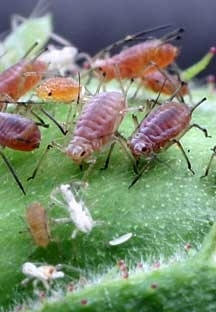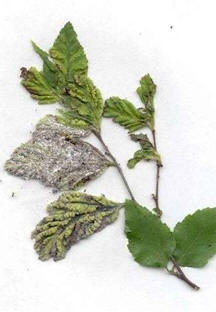Aphids

DESCRIPTION
Many species of Aphids (sometimes called plant lice) occur on ornamental trees and shrubs in Pennsylvania. Certain species feed on foliage, others on twigs and branches, flowers or fruit, and some on roots. They feed on both coniferous and deciduous plants. Effective control of Aphids has been a problem to homeowners and landscape managers for years. Some of the more common Aphids include the Green Peach Aphid, Melon Aphid, Tuliptree Aphid, Giant Bark Aphid, White Pine Aphid, and Rose Aphid. Aphids constitute a large group of small, soft-bodied insects. They may measure up to 6 mm in total length. Aphids have piercing-sucking mouth parts which enable them to remove plant fluids from a host. Aphids generally can be recognized by their pear-like shape, a pair or cornicles at the posterior of their bodies and fairly long antennae. Aphids vary in color from green, yellow, red, purple, brown or black.
LIFE CYCLE
The life history of many Aphids is complex and unusual. Enormous populations of Aphids can be built up in a short period of time. Although considerable variation occurs between species, a typical life history is described as follows. Aphids generally overwinter as fertilized eggs. With the approach of Spring weather, the eggs hatch into nymphs which rapidly mature into wingless females. Each of these Aphids is responsible for producing a large colony of Aphids and is referred to as a stem mother. Stem mothers produce female nymphs without mating. Successive wingless generations are produced until the Aphid colony becomes overcrowded. When overcrowding occurs, a generation of winged females is produced that will migrate to other host plants. These winged females are referred to as Spring migrants. Spring migrants continue to produce successive generations until the end of the Summer when winged males and females are produced. The winged females return to the Spring host. They are sometimes referred to as Fall migrants. These individuals produce females which mate with males of the previous generation. These mated females lay eggs that overwinter.
 DAMAGE
DAMAGE
Aphids are common, persistent, and sometimes troublesome pests of ornamental plants. Most aphids cause damage to host plants by robbing them of plant fluid, by the toxic action of their salivary secretions injected during feeding, and by serving as vectors of viruses that are harmful to plants. Feeding by Aphids can stunt plant growth, deform leaves and fruit, or cause galls on leaves, stems and even roots. Many Aphids also excrete a sticky, sugar-containing substance known as honeydew. This material will drop onto the leaves, twigs, and fruit of a plant. A black, sooty mold soon begins to grow on this sugar-rich substrate. This mold not only mars the appearance of the plant, but when abundant, will also reduce the food-making process of a plant known as photosynthesis. Honey dew is attractive to ants, flies, hornets, and yellowjackets. It can also mar cars, chairs, tables or other objects that are beneath Aphid-infested plants.
CONTROL
Non-Chemical
In some cases, proper pruning, fertilizing, and watering play an important role in preventing or suppressing an Aphid infestation. Beneficial insects play an important role in Aphid control. Ladybird beetles, lacewings, some flower flies and tiny parasitic wasps will use Aphids as a source of nourishment for their development. Remember certain insecticide applications will destroy these beneficial insects as well as the targeted pest species. This practice could leave trees and shrubs unprotected if pest populations should increase in the future.
Chemical
Formulations of acephate (Orthene), cyfluthrin (Tempo), horticultural spray oil (Sunspray 6E, Sunspray Ultrafine Spray Oil, etc.), insecticidal soap (M-Pede, Insecticidal Soap, etc.), imidicloprid (Merit) and several other insecticides are labeled for Aphid control.* Follow all label directions for specific information on host plant label clearance, phytotoxicity information, safety precautions and dosage information.
* See Woody Ornamental Insect, Mite and Disease Management, The Pennsylvania State University (2005) for more details.
WARNING: Pesticides are poisonous. Read and follow directions and safety precautions on labels. Handle carefully and store in original labeled containers out of reach of children, pets and livestock. Dispose of empty containers right away , in a safe manner and place. Do not contaminate forage, streams or ponds.
For professional assistance with tree and shrub problems contact a Keystone arborist.
Penn State Fact Sheet on Aphids


